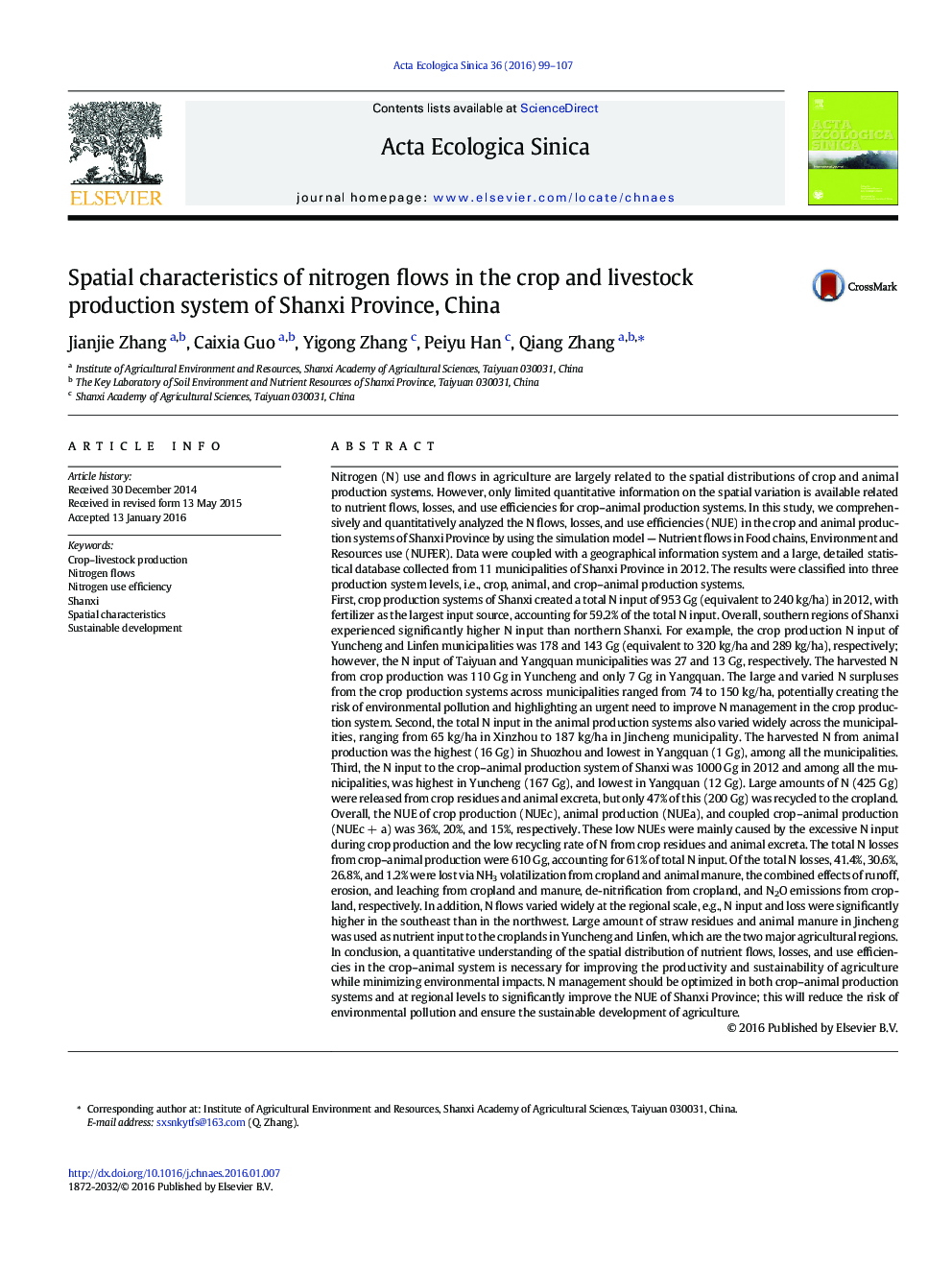| کد مقاله | کد نشریه | سال انتشار | مقاله انگلیسی | نسخه تمام متن |
|---|---|---|---|---|
| 4379752 | 1303934 | 2016 | 9 صفحه PDF | دانلود رایگان |
Nitrogen (N) use and flows in agriculture are largely related to the spatial distributions of crop and animal production systems. However, only limited quantitative information on the spatial variation is available related to nutrient flows, losses, and use efficiencies for crop–animal production systems. In this study, we comprehensively and quantitatively analyzed the N flows, losses, and use efficiencies (NUE) in the crop and animal production systems of Shanxi Province by using the simulation model — Nutrient flows in Food chains, Environment and Resources use (NUFER). Data were coupled with a geographical information system and a large, detailed statistical database collected from 11 municipalities of Shanxi Province in 2012. The results were classified into three production system levels, i.e., crop, animal, and crop–animal production systems.First, crop production systems of Shanxi created a total N input of 953 Gg (equivalent to 240 kg/ha) in 2012, with fertilizer as the largest input source, accounting for 59.2% of the total N input. Overall, southern regions of Shanxi experienced significantly higher N input than northern Shanxi. For example, the crop production N input of Yuncheng and Linfen municipalities was 178 and 143 Gg (equivalent to 320 kg/ha and 289 kg/ha), respectively; however, the N input of Taiyuan and Yangquan municipalities was 27 and 13 Gg, respectively. The harvested N from crop production was 110 Gg in Yuncheng and only 7 Gg in Yangquan. The large and varied N surpluses from the crop production systems across municipalities ranged from 74 to 150 kg/ha, potentially creating the risk of environmental pollution and highlighting an urgent need to improve N management in the crop production system. Second, the total N input in the animal production systems also varied widely across the municipalities, ranging from 65 kg/ha in Xinzhou to 187 kg/ha in Jincheng municipality. The harvested N from animal production was the highest (16 Gg) in Shuozhou and lowest in Yangquan (1 Gg), among all the municipalities. Third, the N input to the crop–animal production system of Shanxi was 1000 Gg in 2012 and among all the municipalities, was highest in Yuncheng (167 Gg), and lowest in Yangquan (12 Gg). Large amounts of N (425 Gg) were released from crop residues and animal excreta, but only 47% of this (200 Gg) was recycled to the cropland. Overall, the NUE of crop production (NUEc), animal production (NUEa), and coupled crop–animal production (NUEc + a) was 36%, 20%, and 15%, respectively. These low NUEs were mainly caused by the excessive N input during crop production and the low recycling rate of N from crop residues and animal excreta. The total N losses from crop–animal production were 610 Gg, accounting for 61% of total N input. Of the total N losses, 41.4%, 30.6%, 26.8%, and 1.2% were lost via NH3 volatilization from cropland and animal manure, the combined effects of runoff, erosion, and leaching from cropland and manure, de-nitrification from cropland, and N2O emissions from cropland, respectively. In addition, N flows varied widely at the regional scale, e.g., N input and loss were significantly higher in the southeast than in the northwest. Large amount of straw residues and animal manure in Jincheng was used as nutrient input to the croplands in Yuncheng and Linfen, which are the two major agricultural regions. In conclusion, a quantitative understanding of the spatial distribution of nutrient flows, losses, and use efficiencies in the crop–animal system is necessary for improving the productivity and sustainability of agriculture while minimizing environmental impacts. N management should be optimized in both crop–animal production systems and at regional levels to significantly improve the NUE of Shanxi Province; this will reduce the risk of environmental pollution and ensure the sustainable development of agriculture.
Journal: Acta Ecologica Sinica - Volume 36, Issue 2, April 2016, Pages 99–107
